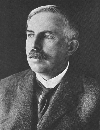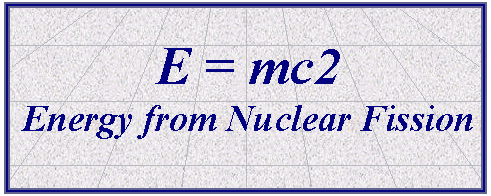 |
This is quite a long page. Although it is designed to be read sequentially, a menu is provided in order that you can access any particular section quickly and easily.
Introduction.
Nuclear fission takes place when a heavy atomic nucleus, such as uranium, breaks into two or more smaller pieces with the release of some energy. During this process some of the mass of the original atom is converted into energy in accordance with the equation E = mc2.
The idea that there might be a way to get at the energy locked up in an atom's mass took time to catch on. Einstein himself thought it would never happen, and in an address given in England in 1933 the eminent atomic physicist and discoverer of the nucleus of the atom, Ernest Rutherford, said:
"The energy produced by the breaking down of the atom is a very poor kind of thing. Anyone who expects a source of power from the transformation of these atoms is talking moonshine."
However, within 10 years the world's first nuclear reactor had been built and by the mid-1950s nuclear power stations started supplying electrical power for industrial and domestic use.
The atoms of many different heavy elements undergo fission, but this page looks at just uranium. We will start by explaining how fission takes place and then look at some examples of its use.
|
|
|
Ernest Rutherford (1871-1937) |
Isotopes and Half-life.
From previous pages in this series we know an element is defined by the number of protons in its nucleus. For example, carbon has 6 protons, but can have different numbers of neutrons at its nucleus. Adding together the number of protons and neutrons gives us the isotope of the element, such as carbon-11 or carbon-14. However, in all cases carbon still has 6, and exactly 6, protons.
In the same way, there are different isotopes of uranium. By far the most common are uranium-238 (99.3%) and uranium-235 (0.7%). In both cases they have 92 protons at their nucleus, and the bulk of each isotope is composed of neutrons. Uranium-238 is a stable isotope, that is, it only rarely undergoes any form of radioactive decay. Uranium-235 is also stable but undergoes radioactive decay a little more frequently.
All atoms decay, that is, fall apart. Some of them take a very, very short time (a few billionths of a second) and some a very, very long time (possibly 1031 years for hydrogen). We can't say when an individual atom will decay, but we can use statistical techniques to say how long it will be before a lot of atoms of a particular type decay to half of their original amount. This is called the half-life of an element. For example, carbon-14 has a half-life of 5730 years. That is, if we had a jar of carbon-14 and left it on a shelf for 5730 years half of it would have decayed into another element (nitrogen-14) and we would be left with only half the original amount of carbon. Likewise, if we left it for another 5730 years, half of the carbon we had left would have decayed and no longer be carbon, and so on:

Fission in Uranium-235.
Uranium-235, while being less stable that uranium-238, is still quite a stable atom. If left by itself it has a half-life of 7.1 ´ 108 years. However, it was discovered that if an atom of uranium-235 is struck by a neutron (symbol n), the neutron initially sticks to the atom to make uranium-236. This is a very unstable isotope and decays rapidly by splitting into lighter atoms and particles. This is called induced fission. There are many different "channels" through which uranium-235 can decay, i.e. there are many different particles that can result from the decay. We will look at the most common one; that of uranium-235 splitting into barium, krypton and three neutrons.
First we fire a neutron (n) at the uranium-235 (U-235) atom so that it sticks to it. After a short while the uranium-235 splits into an atom of barium-141 (Ba-141), an atom of krypton-92 (Kr-92) and three neutrons. We can show this schematically. Firstly, the neutron striking the uranium-235 atom to make a uranium-236 atom:
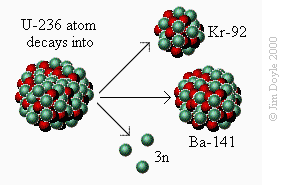
Secondly, the new uranium-236 atom rapidly decays into an atom of Ba-141 (barium), an atom of Kr-92 (krypton) and three neutrons:
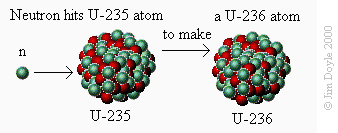
The resulting particles and atoms all have kinetic energy. This energy comes from converting a little of the mass of the original atom into energy and can be measured using E = mc2. When this is done, the amount of energy typically released in the case of U-235 is around 200MeV (0.00,000,000,003,204 joules). That, it seems, is a very tiny amount of energy. However, it is about a million times more energy than is released by the burning of one molecule of petrol (gas) in a car's engine. Put another way, if you currently use a tank of petrol each week but could use the energy provided by one tank of uranium-235 fission instead, you wouldn't need to re-fill your car for over 19,000 years!
We have seen that we can induce an atom of uranium-235 to undergo fission by bombarding it with neutrons. Does this mean we have to keep bombarding a lot of U-235 with a lot of neutrons in order to get any useful energy out of it? No, we let the uranium do it for us. In the previous section we saw that along with barium and krypton, three neutrons are released during the fission process. These neutrons can hit further U-235 atoms and split them, releasing yet more neutrons. This is called a chain reaction:
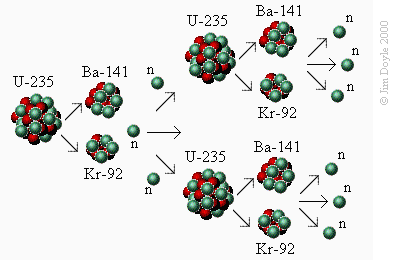
All we have to do is get enough U-235 in one place. If we do that we don't even need to supply the first neutron. Although the half-life of U-235 is a very long time, if we get enough of the atoms together in one place the chances that any one of them will undergo spontaneous fission is very, very high. This was first done at the end of 1942 in a disused squash court under the University of Chicago's Stagg Field stadium. Graphite bricks containing U-235 were piled up in a box shape and a single brick was lowered into the box. Lowering the last brick was just enough to start a chain reaction in the U-235 as more and more neutrons were released as a result of nuclear fission. Looking back on this event it is almost unbelievable that the experiment was allowed to go ahead! However, at the time no one was really sure of the full affects of radiation and with World War II raging the safety of individuals was second to carrying out what was seen as vitally important work. Not only had the scientists (lead by the brilliant Italian, later American, physicist, Enrico Fermi) created the world's first self-sustaining nuclear reactor, but had the cable holding the last brick snapped they would have been witness to the world's first nuclear meltdown!
Atomic Bombs.
At the end of the last section I used the word "meltdown". A meltdown is when there is a runaway fission chain reaction. More and more neutrons are released hitting more and more U-235 atoms, producing so much heat that everything around the uranium melts. An atomic bomb can be thought of a very rapid meltdown.
The idea behind an atomic bomb is really very simple: bring lots of uranium-235 together very quickly so that it undergoes very rapid fission. This can be done in a number of ways, for example by causing a conventional explosion around a lump of high-grade (i.e. high density) U-235. This causes an "implosion", crushing the U-235 together to the point at which fission very rapidly takes over and a huge explosion results as all the particles fly apart, together with a lot of heat and light that is also released during the fission process.
Conventional bombs during the Second World War were filled with a derivative of the explosive TNT (trinitrotoluene). The standard weight of the bombs dropped by the large bombers of the allies was 1000 pounds (454kg). The first of the two atom bombs used in WWII had the same explosive power as about 20 kilotons (20,000 tons, or 18,144 tonnes) of TNT. That is about the same explosive power as about 40,000 conventional bombs. It is sobering to realise that the enormous amount of explosive energy released when the first atomic bomb was dropped was produced by about the amount of uranium-235 that could be held in a coffee mug.
Nuclear Power Stations.
Nuclear power stations generally use plutonium, as do modern atomic bombs. This element is slightly heavier than uranium and is made (it doesn't naturally occur) by bombarding uranium-238 with neutrons. In this way the the vast bulk (99.3%) of mined uranium can still be used to provide energy. The process of turning uranium into plutonium is sometimes referred to as "breeding", and "fast breeder reactors" are used for this purpose.
A nuclear power station works in pretty much the same way as any other power station, only the energy source is different. Generally, rods of fissional material (plutonium) are pushed together until a controlled amount of heat is produced. This heat is used to produce steam, which is forced at high pressure through a set of turbine wheels. The turbine wheels are connected to a generator and electricity is produced.
Producing electricity in this way is very cheap. In fact, during the 1950s it was even thought that using nuclear fission as the primary energy source electricity would be so cheap that it would be free to the end user because it wouldn't be worth charging for it! However, while the actual conversion of radioactive energy (via E = mc2) into electrical energy is, on a large scale, very cheap, it is now being realised that other aspects of such an undertaking can be expensive. Nuclear power stations have problems that other, conventional, power stations don't have, such as extra security costs, and the costs of decommissioning old stations in a safe way. On the other hand, conventional power stations have come under worldwide scrutiny in recent years because of the levels of toxic and ozone destroying emissions. Arguments about which is the "best" source of electrical energy will no doubt continue for some time yet. In the meantime, most western (and many eastern) countries use nuclear power stations to provide around 20% of the total electrical power produced.
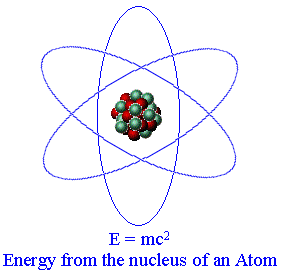
E=mc^2 Energy from Nuclear Fission
Alıntı: http://www.btinternet.com/~j.doyle/SR/Emc2/Fission.htm
Hiçbir yazı/ resim izinsiz olarak kullanılamaz!! Telif hakları uyarınca bu bir suçtur..! Tüm hakları Çetin BAL' a aittir. Kaynak gösterilmek şartıyla siteden alıntı yapılabilir.
The Time Machine Project © 2005 Cetin BAL - GSM:+90 05366063183 -Turkiye/Denizli
Ana Sayfa /İndex /Roket bilimi / ![]() E-Mail /CetinBAL /Quantum Teleportation-2
E-Mail /CetinBAL /Quantum Teleportation-2
Time Travel Technology /Ziyaretçi Defteri / Duyuru / UFO Technology
